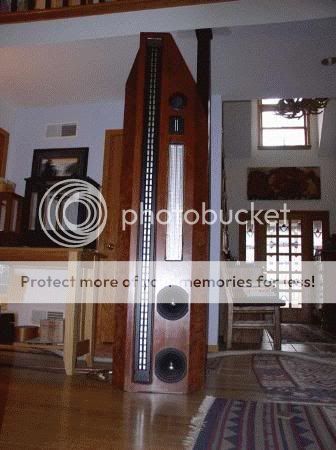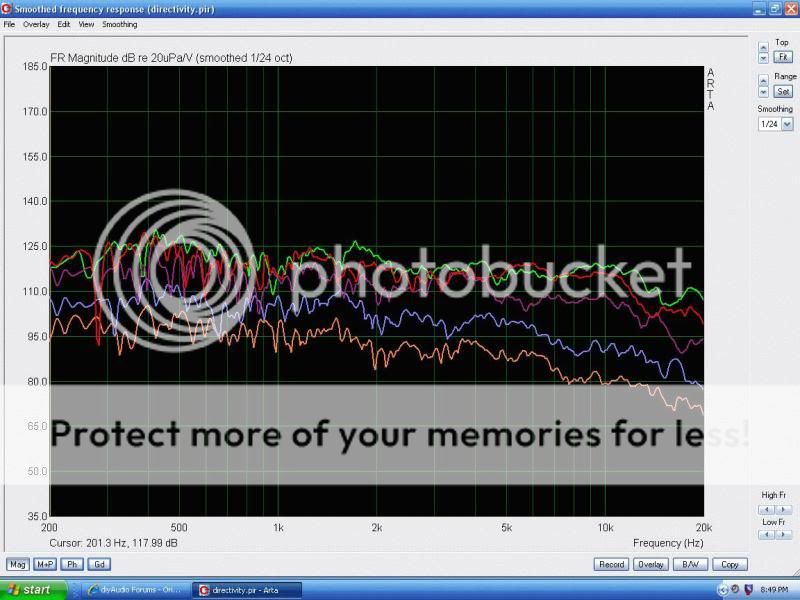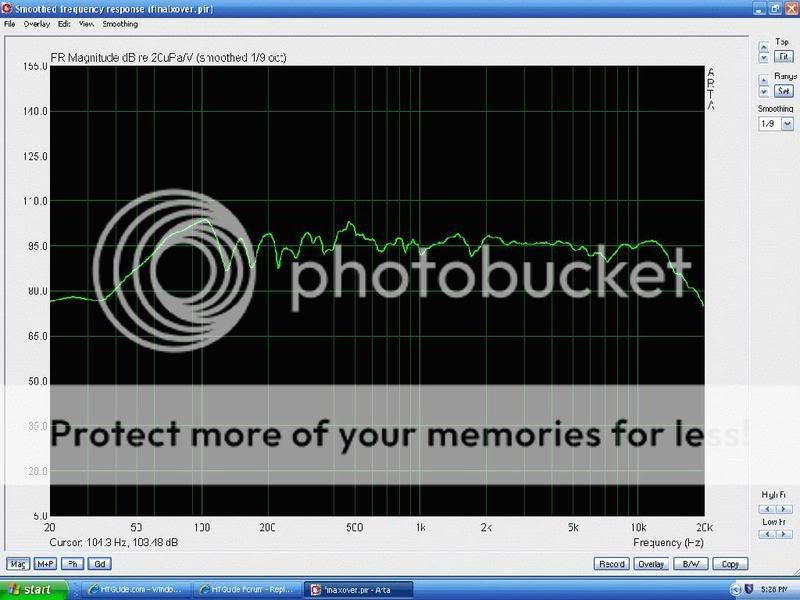Hi Stig,
I am in the same boat as you (may be half of the same boat) coz I wanted to build a high sensitivity DIY Open Baffle Line Array with Planars. But I wanted to use powered subs in sealed enclosure for the low ends and everything else in OB. I wanted to avoid baffle as much as possible so a thin baffle is my choice. I am reading a lot about suitable materials and design ideas for use with thin frame for OB use.
I guess it'll be some combination of wood frame and some specially made aluminum and steel.
But I am hitting the dead end since I can't find a suitable High Sensitivity drivers for mids and mid-bass. I need a suitable drivers from 100-150Hz to the 6KHz. I prefer drivers to be ESL or Planar Magnetics line source such as RD75 but they are not too sensitive drivers. There are sensitive conventional cone drivers but having them work in dipole solution doesn't seen ideal.
Have you come across any suitable drivers for my application?
I am in the same boat as you (may be half of the same boat) coz I wanted to build a high sensitivity DIY Open Baffle Line Array with Planars. But I wanted to use powered subs in sealed enclosure for the low ends and everything else in OB. I wanted to avoid baffle as much as possible so a thin baffle is my choice. I am reading a lot about suitable materials and design ideas for use with thin frame for OB use.
I guess it'll be some combination of wood frame and some specially made aluminum and steel.
But I am hitting the dead end since I can't find a suitable High Sensitivity drivers for mids and mid-bass. I need a suitable drivers from 100-150Hz to the 6KHz. I prefer drivers to be ESL or Planar Magnetics line source such as RD75 but they are not too sensitive drivers. There are sensitive conventional cone drivers but having them work in dipole solution doesn't seen ideal.
Have you come across any suitable drivers for my application?
Have you come across any suitable drivers for my application?
No, not really. The best option is the big RD-75, but sensitivity is a bit low (88 dB). If you're made from money you could build a line-array using multiple AMT's. They big Beyma is 100 dB sensitive...
A few questions StigErik??
I have built a frame and am ready to hang my 2 x 6.5" drivers each side but they seem to want to hang on an angle.
How have you overcome this issue? I have studied your photos but am still unclear and thought perhaps you might be able to shed some light.
Cheers for the help.
Dean
PS... More drivers to be added later for all the obvious reasons.
I have built a frame and am ready to hang my 2 x 6.5" drivers each side but they seem to want to hang on an angle.
How have you overcome this issue? I have studied your photos but am still unclear and thought perhaps you might be able to shed some light.
Cheers for the help.
Dean
PS... More drivers to be added later for all the obvious reasons.
You have to suspend them from the weight balance point, which is somewhere in the middle between the front and back, depending on the magnet weight. I fixed it by using long bolts through the driver frame, and attaching the suspension wire (or whatever) at the point where it all is in balance.
Like this:
Like this:
An externally hosted image should be here but it was not working when we last tested it.
Thanks, StigErik, for sharing so much about your work!
Concerning the listening experiences you describe: I guess the larger stereo image and less defined imaging is due to the much higher level of early reflections and reverberant sound. Since Floyd Toole et al. argue that image broadening or higher apparent source width caused by lateral reflections is preferred by listeners over more precise imaging, my question is: What sound do you prefer, if you can tell yet - that of the line array or that of your "old" speakers?
Apart from the subjective side, it would be quite interesting to see a measurement comparison, especially for the off axis frequency response of both speakers.
Concerning the listening experiences you describe: I guess the larger stereo image and less defined imaging is due to the much higher level of early reflections and reverberant sound. Since Floyd Toole et al. argue that image broadening or higher apparent source width caused by lateral reflections is preferred by listeners over more precise imaging, my question is: What sound do you prefer, if you can tell yet - that of the line array or that of your "old" speakers?
Apart from the subjective side, it would be quite interesting to see a measurement comparison, especially for the off axis frequency response of both speakers.
Wowo101: I wish I could have both the scale of the line-source dipoles and the precision of the point-source dipoles... but that imaging thing is not the reason why I still prefer the "old" speakers. I do prefer the dynamics and more involving character of the "old" ones.
Joachim: good point, I can try that with the RD-75 ribbons, or maybe some foam on the edges? With my "old" speakers diffraction do not seem to be a problem, at least it's not affecting image sharpness.
Joachim: good point, I can try that with the RD-75 ribbons, or maybe some foam on the edges? With my "old" speakers diffraction do not seem to be a problem, at least it's not affecting image sharpness.
Concerning edge diffraction, I didn´t see (or hear) much effect when putting open cell foam around my Neo3s which seem similar in their exterior construction to the RD75s. Next I´ll try some short quasi-waveguides made of PVC tube segments, hopefully somewhat replicating what JohnK achieved with his NaO Note.
Still, I guess the image smearing might be due to the different dispersion pattern of the line array. But of course to verify this guess one would need to compare some measurements...
Still, I guess the image smearing might be due to the different dispersion pattern of the line array. But of course to verify this guess one would need to compare some measurements...
Yes, this is exactly what I thought. But if this is the case, then it will always be either imaging width or imaging precision, never both...
But since you said the main advantage you see in the "old" dipoles is better dynamics of the cone midranges, the question would be if it´s possible to achieve a horizontal dispersion pattern similar to the dipole array, but using cone drivers for the midrange. Using smaller drivers comes to mind, reducing beaming in the upper midrange region. But then again, I know too little about line sources to make any judgement about their horizontal dispersion patterns compared to that of cone drivers...
But since you said the main advantage you see in the "old" dipoles is better dynamics of the cone midranges, the question would be if it´s possible to achieve a horizontal dispersion pattern similar to the dipole array, but using cone drivers for the midrange. Using smaller drivers comes to mind, reducing beaming in the upper midrange region. But then again, I know too little about line sources to make any judgement about their horizontal dispersion patterns compared to that of cone drivers...
RD 75's
While I built my Rd 75 Dipoles baffled 5 yrs. ago, and don't much hear any great advantage in "CD" in practice, I certainly don't have any dynamic range issues with them...xover @ 600 Hz
slight downward tilt from ~ 1Khz up is personal preference... these will measure flat, but that sounds too brite to me...
2nd plot is off axis @15, 30, 45, & 60 degrees @ 3 meters


Set-up flat... sounds too shrill

John L
While I built my Rd 75 Dipoles baffled 5 yrs. ago, and don't much hear any great advantage in "CD" in practice, I certainly don't have any dynamic range issues with them...xover @ 600 Hz
slight downward tilt from ~ 1Khz up is personal preference... these will measure flat, but that sounds too brite to me...
2nd plot is off axis @15, 30, 45, & 60 degrees @ 3 meters


Set-up flat... sounds too shrill

John L
Last edited:
I think the the most likely reason for the (slight) image smearing of the line sources is higher room reverberation. I measured that the room decay was about 10 dB louder than with the "old" dipoles.
How about the side-by-side arrangement of the cone line and the RD75 line? Do you hear much difference between off axis left and right? Or is each line "transparent" for the other?
Can anybody recommend some reading or formula for finding/understanding 'Dipole Peak'.
My explanation The third (bottom) download on that page.
Rudolf
How about the side-by-side arrangement of the cone line and the RD75 line? Do you hear much difference between off axis left and right? Or is each line "transparent" for the other?
I'm not sure what you mean here Rudolf...
Sorry, obviously I have to be more explicit.
It could be that the RD75 line "sees" the woofer line as a kind of baffle extension - or if it is acoustically "transparent" for the RD75s. If not transparent, the RD75s would not be in the middle of their baffle, but offset to the left (or right). That offset would lead to a change in the sideways radiation pattern - purer highs to the "short" side and more mids to the "long" side.
I was considering if this could be a source of the slightly smeared imaging too.
Rudolf
It could be that the RD75 line "sees" the woofer line as a kind of baffle extension - or if it is acoustically "transparent" for the RD75s. If not transparent, the RD75s would not be in the middle of their baffle, but offset to the left (or right). That offset would lead to a change in the sideways radiation pattern - purer highs to the "short" side and more mids to the "long" side.
I was considering if this could be a source of the slightly smeared imaging too.
Rudolf
imaging
With my setup, at least, I find much greater imaging variation between different program material than with changes in physical speaker location and/or design characteristics. That's not to say there aren't differences, but I perceive exquisite imaging on some orchestral, female/male vocal, and solo or small ensemble instrumentals, while others are diffuse and scattered about in "larger than life" perspective, both l/r and front to back. HT (movie) presentations seem to be altogether different as well, often much more enveloping than typical music recordings
I can only attribute this to variations in miking and or recording techniques... seems to greatly confound theoretical vs. practical interpretations.
John Lichtenberger
Sorry, obviously I have to be more explicit.
It could be that the RD75 line "sees" the woofer line as a kind of baffle extension - or if it is acoustically "transparent" for the RD75s. If not transparent, the RD75s would not be in the middle of their baffle, but offset to the left (or right). That offset would lead to a change in the sideways radiation pattern - purer highs to the "short" side and more mids to the "long" side.
I was considering if this could be a source of the slightly smeared imaging too.
Rudolf
With my setup, at least, I find much greater imaging variation between different program material than with changes in physical speaker location and/or design characteristics. That's not to say there aren't differences, but I perceive exquisite imaging on some orchestral, female/male vocal, and solo or small ensemble instrumentals, while others are diffuse and scattered about in "larger than life" perspective, both l/r and front to back. HT (movie) presentations seem to be altogether different as well, often much more enveloping than typical music recordings
I can only attribute this to variations in miking and or recording techniques... seems to greatly confound theoretical vs. practical interpretations.
John Lichtenberger
John,
I believe, what StigErik is talking about is much more subtle than what some sound engineers are doing to their recordings.
I've got orchestral recordings where the engineer obviously didn't want to separate any parts of the orchestra from one another. One hundred musicians crowded in a 20° space and the rest of the stereo basis full of reverb.
When I talked about the asymmetry of baffles, it should only affect finer details - not mixing up the whole sound stage.
Rudolf
I believe, what StigErik is talking about is much more subtle than what some sound engineers are doing to their recordings.
I've got orchestral recordings where the engineer obviously didn't want to separate any parts of the orchestra from one another. One hundred musicians crowded in a 20° space and the rest of the stereo basis full of reverb.
When I talked about the asymmetry of baffles, it should only affect finer details - not mixing up the whole sound stage.
Rudolf
- Status
- This old topic is closed. If you want to reopen this topic, contact a moderator using the "Report Post" button.
- Home
- Loudspeakers
- Multi-Way
- Dipole line-array idea